Alocasia Care Indoors: Structure-Based Guide to Growth, Substrate & Real Fixes
- Foliage Factory
- Aug 31, 2024
- 25 min read
Updated: Aug 7
Not for the Forgetful: Alocasia Demands Engagement
With their dramatic silhouettes, sculptural textures, and lush presence, Alocasia plants have become icons in modern plant collections. But let’s be clear: this isn’t the right choice if you're looking for something low-maintenance or “unbothered.”
Alocasia thrives on consistency — not neglect.
What looks like a simple leaf drop could be a dormancy cue… or a sign you’ve buried the rhizome too deep. Watering mistakes? They don’t go unnoticed. And don’t expect every species to behave the same — a macrorrhizos and a cuprea have entirely different underground structures and care needs.
This guide cuts through vague tips and generalizations. You’ll learn:
Whether you’re dealing with a rhizome, stolon, or corm
How habitat affects substrate, humidity, and light
Why some plants “rest” and others rot
How to propagate without guesswork
What each species really needs
If you're ready to stop guessing and start understanding, let’s get into it.

Contents:
1. What Is Alocasia? Botanical Identity Explained
Alocasia is a genus in the Araceae (arum) family, with roughly 90 accepted species spread across tropical Asia and the western Pacific — from the eastern Himalayas through Borneo, the Philippines, and into New Guinea.
➜ Name origin:
The name Alocasia comes from the Greek “a-” (meaning “not”) and Colocasia — signaling early confusion between the two genera. Simply put: Alocasia ≠ Colocasia.
➜ Species or Hybrid — Why It Matters
Many popular Alocasias aren’t wild species at all. They're cultivated hybrids or named cultivars — and that changes what to expect.
Species: Wild-type plants like Alocasia macrorrhizos or A. cuprea
Hybrids: Crosses like Alocasia × amazonica (sanderiana × longiloba)
Cultivars: Named selections like ‘Polly’, ‘Black Velvet’, or ‘Frydek’
➜ Why you should care:
Hybrids often behave differently from species
Cultivars may be more compact or sensitive
Knowing the origin helps you plan substrate, pot size, and watering properly
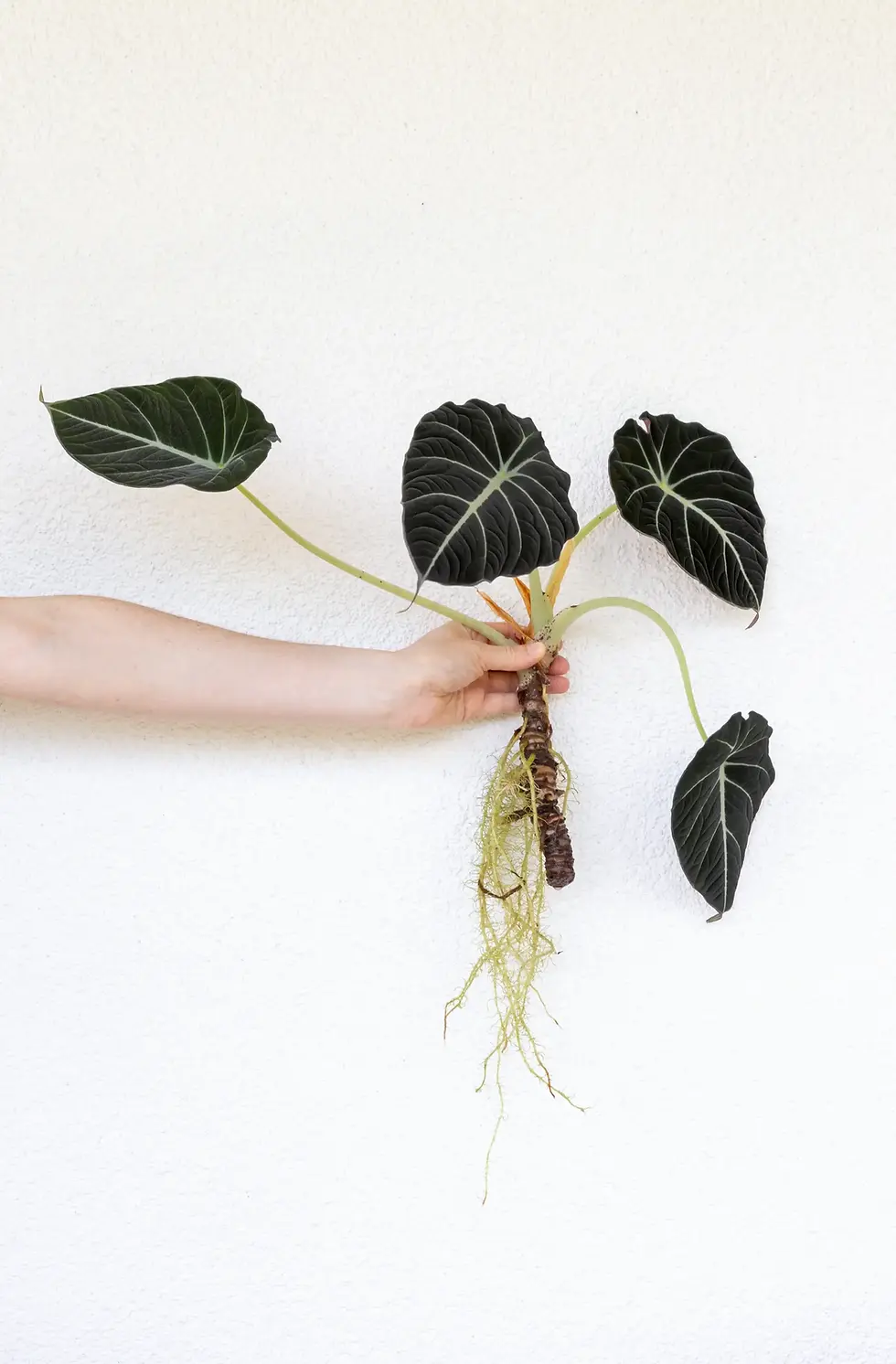
2. What’s Underground: Rhizomes, Stolons, and Cormels
Alocasia care starts below the surface. Whether it spreads sideways or stays tight in a crown tells you everything about how to pot, water, and propagate it.
Rhizomes: Creeping Horizontal Stems
These are thick, underground stems that grow just beneath or at the soil surface. They send out shoots and roots as they expand — often creating multi-stemmed plants over time.
Examples:
Alocasia macrorrhizos
A. portei
A. cuprea
A. azlanii
A. longiloba
Types:
Compact rhizomes: azlanii, cuprea
Elongated, swollen rhizomes (“sub-cormous”): longiloba
Stolons & Cormels: Energy Storage + Propagation
Some Alocasias don’t just spread rhizomatously — they send stolons underground that end in cormels, like little bulbs. These aren’t the same as rhizomes, and they don’t transform into them.
Examples:
A. brancifolia (long stolons with cormels)
A. infernalis, A. sinuata (tight cormel crowns)
❗ Myth check: “Corms become rhizomes” — not true. Rhizomes and cormels are botanically distinct structures.
Root Structure Cheat Sheet:
Structure | Traits | Care Implications |
Rhizome | Spreads laterally, forms offsets | Use a wide, shallow pot; expect side shoots |
Corm/cormel | Compact, stores energy | Smaller pot; warmth + humidity help rooting |
Stolon + cormels | Sends underground runners | May sprout at distance — repot gently |
💡Recognizing the growth type = smarter pot choice, substrate depth, and timing for repotting or propagation.

3. From Forest Floor to Floodplain: Native Niches Define Care
Not all Alocasias are rainforest dwellers. They’ve evolved to thrive in three key environments — and each one affects your care decisions.
Rainforest Understory Species
Think shaded slopes, fog, and fast-draining soils.
Examples: | Traits: | Care Notes: |
|
|
|
💡 A. cuprea is found at 1,000–1,500 m in Borneo on sandstone slopes — wet air, fast runoff, minimal soil.
Swamp-Edge & Floodplain Species
These plants handle water fluctuation — they evolved near streams and paddies.
Examples: | Traits: | Care Notes: |
|
|
|
💡 A. macrorrhizos grows in riverbanks and drainage ditches — and can reach 4 m outdoors.
Rocky Slope & Disturbed Habitat Species
These are fast-draining, full-light specialists.
Examples: | Traits: | Care Notes: |
|
|
|
💡 A. nycteris grows on limestone outcrops — it likes high humidity, but not soggy soil.
Summary Table
Habitat | Traits | Care Focus |
Rainforest understory | Thick leaves, slow growth | High humidity, fine airy mix |
Swamp/floodplain | Robust rhizomes, fast growth | Bright light, regular water, chunky mix |
Rocky slope | Tough rhizomes, high drainage | Gritty mix, airflow, sparse watering |

4. Substrate & Container Strategy: Match the Roots, Not the Trends
Alocasia care doesn’t start with watering or lighting — it starts with the substrate. If your plant’s roots are buried in soggy peat or packed too deep in a pot, it won’t matter how much light it gets.
➜ What Alocasia Roots Really Want
Alocasia roots are:
Oxygen-sensitive — they rot fast in compacted or stagnant mixes
Surface-focused — most feeder roots live in the top 2–5 cm
Prone to rot — especially when the crown is buried or water pools at the base
💡 Tip: If your pot is too deep, or your mix collapses and stays wet at the bottom, root health declines before symptoms even appear above ground.
Substrate by Function — Not Just Ingredients
Forget the generic “aroid mix.” That phrase means nothing if it doesn’t match your plant’s root form and habitat type. Here’s what actually matters:
✓ A Good Alocasia Substrate Must:
Drain fully within 30–60 seconds
Stay aerated — doesn’t slump into sludge
Hold some moisture in the top layers
Allow rhizome airflow
Buffer nutrients without staying soaked
➜ Mix Templates — By Growth Type
Plant Type | Recommended Mix |
Jewel-types (cuprea, azlanii) | Fine bark + coir + pumice — avoid peat or compost |
Large species (macrorrhizos) | Coarse bark + pumice + a touch of coir or worm castings |
Rocky slope species (nycteris) | XL bark + pumice + scoria or akadama |
❗ Avoid peat-heavy or compost-based mixes. They collapse fast, become hydrophobic, and suffocate roots — especially in still air or shallow pots.
🔗 For more context on function-first substrates, read The Ultimate Guide to Houseplant Substrates.
Pot Size & Depth: Rhizomes Hate Sinking
Don’t size your pot to match the leaves. Alocasia roots and rhizomes tell you what kind of container they need.
Potting Rules by Growth Form:
Growth Type | Best Pot |
Creeping rhizomes | Wide and shallow, surface airflow is key |
Compact tubers / corms | Shallow but stable — don’t oversize |
Tall, upright species | Medium-deep pot, but never oversized |
📌 Rule of thumb: Always position the rhizome at or slightly above the soil surface. Never bury it.
💡 Tips for Potting Success:
Avoid overpotting — it slows root establishment and increases rot risk
Good drainage is non-negotiable — holes + airy substrate
Repot only when needed — better to be slightly root-bound
In shallow pots, top layers dry evenly — perfect for feeder roots
Deep pots often hold stagnant, low-oxygen zones — root death starts silently
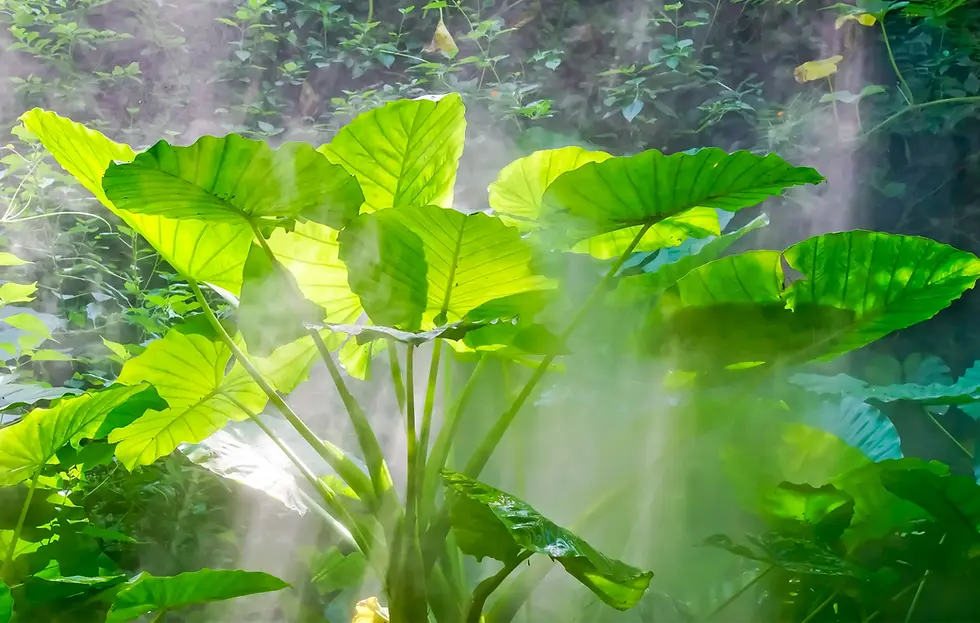
5. Environmental Balance — Light, Humidity, and Airflow in Sync
Alocasia doesn’t just “sit” in its environment — it responds to it. Curling, yellowing, dropping leaves, or stunted growth are rarely random. They’re signals that one or more environmental factors are out of sync.
💡 Think like the plant:
“Do I have enough light to make energy? Enough humidity to stay turgid? Enough airflow to breathe?”
Light = Energy, Not Just Direction
The term “bright indirect light” is too vague to be useful. What matters is intensity — how much usable light the plant actually gets over time.
Ideal Indoor Light for Alocasia:
Metric | Target Range |
PPFD (μmol/m²/s) | 200–600 |
Foot-candles | ~1,000–3,000 |
Color temperature | 4,000–6,500K (neutral to cool white) |
General Light Tips:
Morning sun (east-facing) is often safe and helpful
Avoid harsh midday sun unless diffused through sheer curtains
Match light to species:
macrorrhizos, portei, odora tolerate brighter conditions
azlanii, cuprea, reginula prefer medium filtered light
💡 Not enough light = leggy growth, weak petioles, leaf loss.Too much = bleaching, edge crisping, or shut-down.
Humidity — The Silent Driver
Alocasias don’t just prefer humidity — they function better in it. In dry air, transpiration spikes while leaf hydration drops. This leads to edge crisping, curling, and stalling.
Ideal Humidity by Plant Type:
Group | Target Range |
Jewel-types (azlanii, reginula) | 70–85% |
Large species (macrorrhizos, odora) | 50–60% |
Minimum for all | 50% (absolute baseline) |
Humidity Tips:
Use a humidifier, especially overnight during winter
Cluster similar plants together
Use wide saucers to help with passive evaporation (no pebble trays)
Avoid misting — it increases fungal risk, not real humidity
Always pair humidity with airflow — still, damp air = fungal playground
💡 High humidity without movement encourages bacterial leaf spots and rot.A balanced system includes moisture AND motion.
🔗 Struggling with curling or crispy leaves? Here's how to dial in air moisture without relying on gimmicks: Mastering Humidity for Healthier Houseplants.
Airflow — The Unsung Hero of Healthy Leaves
Poor air circulation is one of the top reasons Alocasias suffer indoors — especially in closed setups or winter-heated rooms.
Tips to Improve Airflow:
Run a small fan on low a few hours per day
Avoid placing near radiators or AC vents
Let air move above and below the leaves
Use mesh nursery pots or breathable containers for root zone airflow
Seasonal Adjustments — With or Without Grow Lights
Alocasia doesn’t follow a strict “go dormant in winter” rule. Instead, it responds to daylight hours, temperature, and light intensity. Here’s how to shift your care accordingly:
Autumn/Winter (No Grow Lights):
Light drops → photosynthesis slows
Humidity drops → transpiration stress
Temps drop → growth slows or stalls
What to Adjust:
Water less often — but don’t let it go bone dry
Raise humidity and keep temperatures above 18 °C
Skip fertilizer unless there’s clear new growth
Watch for longer drying times and adjust rhythm, not schedule
Autumn/Winter (With Grow Lights):
If you maintain ~12–14 h light with good warmth and humidity, your Alocasia may continue growing.
What to Do:
Maintain watering and feeding if growth continues
Fertilize at ¼–½ strength every 3–4 weeks
Repot only if needed — not just because “it’s spring”
📌 Don’t reduce watering just because it’s winter — reduce it when the plant slows down.Let behavior, not the calendar, guide your care.
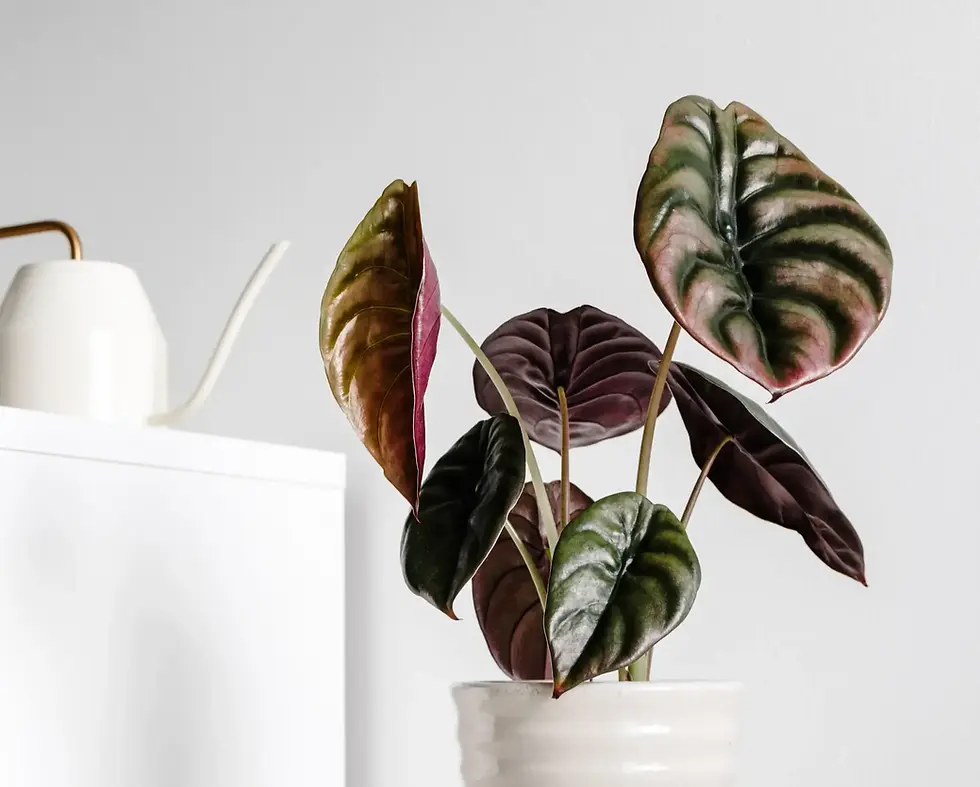
6. Watering Alocasia Without Guesswork
If there’s one area where most Alocasia owners go wrong, it’s watering. Not because the plant is “fussy,” but because its needs shift with light, humidity, and growth stage — and generic schedules don’t work.
Alocasia doesn’t want to stay wet — but it also doesn’t want to dry out completely. What it needs is rhythm.
Watering = Rhythm, Not Routine
Forget fixed schedules. Instead, develop a watering rhythm based on signals — both from the plant and the substrate.
Step-by-step Watering Method:
Insert your finger or wooden stick 2–3 cm deep into the substrate.
If it feels dry (or halfway dry for larger pots), it’s time to water.
Use room-temperature, low-mineral water (filtered, rainwater, or rested tap).
Water thoroughly until it runs out of the bottom.
Discard runoff — don’t let the plant sit in it.
Let the top dry again before the next watering.
Safe Watering Techniques
Method | When to Use | Why It Works |
Top watering | Standard method | Even moisture, flushes salts |
Bottom watering | Rarely, only if mix is airy | Can lead to salt buildup otherwise |
Avoid misting | Always | Promotes fungus, doesn’t increase humidity effectively |
💡 If your substrate is right, watering becomes easy. If the mix holds water too long, no technique can save the roots.
Water Quality: The Silent Killer
Alocasia roots are sensitive to:
Salts
Hard minerals
Chlorine and chloramine
Extreme pH (very acidic or alkaline)
Water Issues Can Cause:
Brown edges
Leaf spotting
Stalled or misshapen growth
Crusty residue on soil surface
Best Water Sources:
Rainwater (best)
Filtered or reverse osmosis water
Tap water rested 24 hours (only if it’s not too hard)
💡 If you’re doing everything right and still getting brown edges — try switching your water source for 2–3 weeks and track the difference.
Watering Red Flags — Know What You’re Seeing
Symptom | Likely Issue | Next Step |
Drooping leaves + mushy petioles | Overwatering or rot | Unpot, check rhizome |
Leaf edges brown or spotted | Bad water quality or salt buildup | Flush or repot |
Curled, crispy leaves | Underwatering or dry air | Adjust humidity + watering |
Substrate stays soggy | Poor mix or pot size | Repot into airy, shallow setup |
📌 Tip: If a plant looks thirsty but the substrate is wet — stop. Something’s blocking uptake, not water availability.

7. Growth Cycles & Dormancy Decoded: What’s Normal, What’s Not
Not all Alocasias “go dormant,” and not all yellow leaves mean trouble. These plants evolved in tropical and subtropical zones where moisture, warmth, and light fluctuate seasonally — and they’ve developed flexible strategies to adapt.
📌 But here’s the key:
There’s no universal dormancy rule.Some species rest when cues change. Others push through year-round if conditions stay right.
True Dormancy vs. Stress vs. Natural Pause
Let’s break it down:
State | What Happens | What To Do |
True Dormancy | Gradual yellowing, leaves drop, rhizome firm | Reduce water, no fertilizer, keep warm and humid |
Stress / Decline | Sudden collapse, mushy stems, foul smell | Unpot, remove rot, repot in airy mix, restart gently |
Pause / Plateau | Leaves stay but growth halts | Hold off on fertilizer and repotting, monitor conditions |
Common Triggers:
Drop in light intensity or day length
Cool temperatures (especially under 16 °C)
Dry air combined with less light
➜ A firm rhizome = resting.
➜ A soft, smelly rhizome = rotting. Know the difference.
📌 Species Tendencies (Observed Indoors)
Species | Dormancy Behavior |
A. reginula, cuprea, azlanii | Often enter semi-dormancy in lower temperatures and/or light levels |
A. macrorrhizos, portei | Usually continue growing if kept warm and bright |
Typical Dormancy Symptoms:
Slow to no new growth
Yellowing older leaves
No root rot if substrate is managed
Can last 4–10 weeks depending on environment
Supporting a Resting Plant (Without Killing It)
Even if your Alocasia isn’t pushing new leaves, it’s still alive — and still needs gentle support.
What to Do:
Keep temperatures 18–24 °C
Water lightly only when the top third of the mix is dry
Don’t fertilize — roots won’t absorb it
Maintain moderate humidity (60%+) with airflow
💡 If everything looks stalled but the rhizome is firm — relax. You’re not doing it wrong.
Think of it like a power nap, not a plant failure.
🔗 If your Alocasia struggles after moving or repotting, check out our Houseplant Acclimatization Guide to understand how light and environment shifts affect growth.
When Growth Resumes — What to Expect
As spring approaches or your conditions improve, your Alocasia will start to wake:
New shoots emerge from the crown or rhizome
Petioles elongate, especially with more light
Leaves appear faster and larger
When You See New Growth:
Resume gentle watering
Fertilize at ¼–½ strength every 3–4 weeks
Consider repotting only if the mix is breaking down or roots are circling
💡Tip: Some rhizomes may take weeks to show top growth — even with new roots underneath. Be patient.
Does Alocasia Need Dormancy?
Technically, no. Alocasia are facultative resters — they can go dormant under stress, but they don’t require it.
What determines it?
Condition | Effect |
Dim light + cold temps | Likely dormancy |
Grow lights + warm air | Year-round growth possible |
Low humidity + inconsistent watering | May trigger leaf drop or stall |
📌 Bottom line: Adapt to the plant’s rhythm, not the calendar. If it’s growing, support it. If it’s pausing, let it rest.
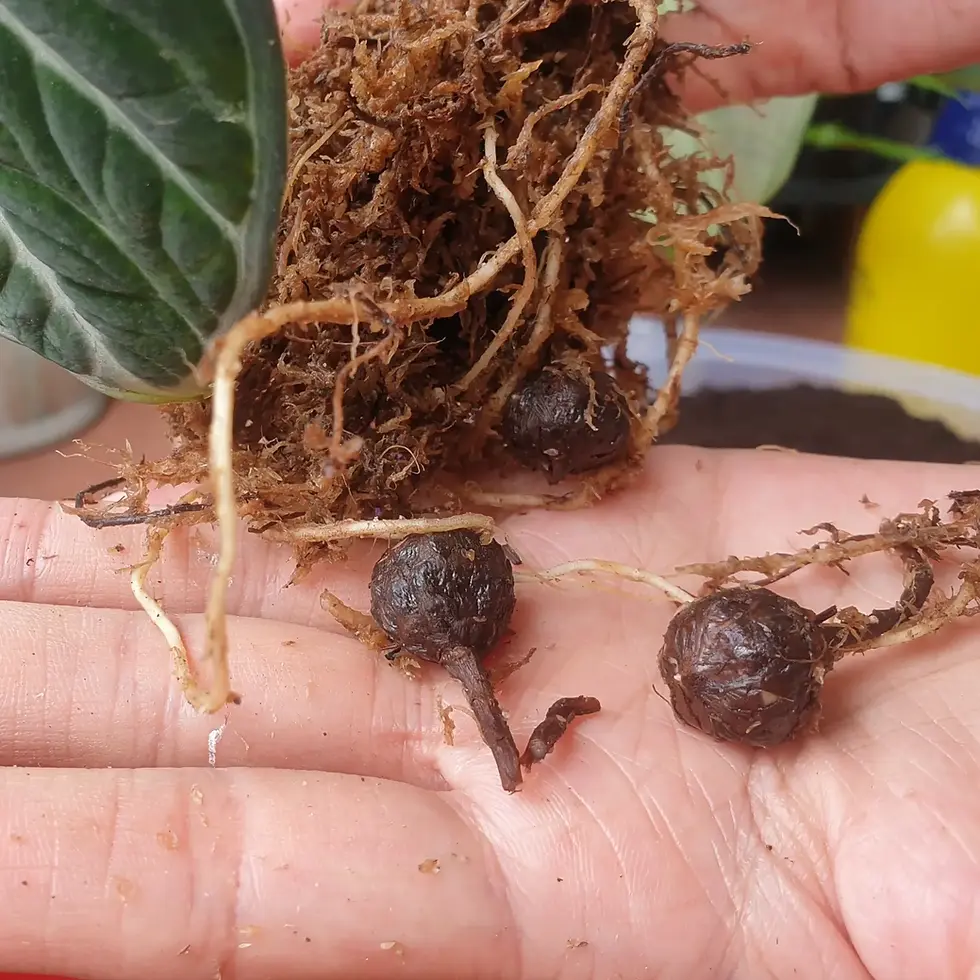
8. Propagation: Rhizomes, Cormels & Offsets Explained
Wondering how to divide Alocasia rhizomes or sprout cormels the right way?
This guide breaks down Alocasia propagation by corm, offset, or division — with no guesswork. Unlike common houseplants that grow roots from a stem cutting, Alocasia reproduces underground. Propagation success depends on what kind of structure your plant grows from — and applying the right technique at the right time.
Know Your Structure → Pick Your Propagation Path
Structure | Examples | Best Method |
Horizontal rhizome | macrorrhizos, portei, reginula | Offset separation or rhizome division |
Condensed rhizome | cuprea, azlanii | Careful offset removal (if present) |
Stolon + cormels | brancifolia, sanderiana types | Cormel harvest and sprouting |
Method 1: Offsets (Pups)
This is the easiest and safest way to multiply most rhizomatous Alocasias. Offsets naturally emerge from the base once the plant is mature enough.
When to Propagate:
The offset has at least 2–3 leaves
Visible roots are attached
It’s the warm growing season
How-To:
Unpot the mother plant gently
Brush or wash away substrate
Identify offsets with their own roots
Twist gently or cut with a sterile blade
Pot in a small container with fresh, airy mix
Keep warm (22–28 °C) and humid until established
💡 Use a humidity dome or transparent cover for the first 2–3 weeks — but vent daily to avoid mold.
Method 2: Rhizome Division
Used mostly for large, established species with sprawling rhizomes (macrorrhizos, portei).
When to Divide:
Plant is root-bound or has multiple growth points
Actively growing — never in dormancy
How-To:
Unpot and gently rinse off the soil
Use a sterilised blade to cut the rhizome into segments
Each piece must have at least one eye or growth node
Let wounds callus for 24h in a warm, dry place
Pot shallowly in a moist, well-draining mix
Keep warm and gently moist (not soggy)
❗ Don’t divide a rhizome that only has one growth point — it’s not ready.You’ll just set it back or cause rot.
Method 3: Cormels & Tubers
Some Alocasia types produce small underground nodules — cormels — from stolons or near the crown. These can grow into new plants but take time.
How to Harvest:
Wait until repotting season
Snap or cut cormels from the parent carefully
Peel away any sheath tissue if needed
Sprouting Setup:
Lay half-buried in moist sphagnum or coir/perlite
Place in a closed container or prop dome
Keep at 25–28 °C with bright, indirect light
Mist lightly every few days
Sprouting time:
anywhere from 2 to 12 weeks depending on species and conditions.
📌Note: Cormel propagation does not guarantee trait stability — especially for hybrids or variegated cultivars. Offspring may revert or look completely different.
Method 4: Seeds (Rare, Advanced)
While possible, seed propagation is rarely used by home growers.
Why?
Most species are self-incompatible — you need two genetically distinct flowering plants
Flowers are small, unremarkable, and fade fast
Seedlings are slow and highly sensitive
If you want to try:
Hand-pollinate within hours of bloom
Germinate in high humidity, 25–28 °C
Expect slow progress and lots of culling
Quick Comparison: Alocasia Propagation Methods
Method | Difficulty | Speed | Best For |
Offsets | Easy | Fast | Most rhizome-based Alocasia species |
Rhizome division | Medium | Fast | Large or root-bound plants like macrorrhizos |
Cormels | Medium | Slow | Jewel types and stolon-formers (e.g. brancifolia) |
Seeds | Hard | Very slow | Rare Alocasia breeding, advanced growers only |
Most Alocasias propagate best through vegetative means — because it’s reliable, faster, and more likely to produce a true-to-type plant.
9. Species Spotlight: 6 Alocasias, 6 Growth Strategies
Not all Alocasias are created equal. Some creep sideways, others grow upright from a dense crown. Some tolerate dry air — others collapse at the first humidity drop.
Understanding your specific plant’s growth form, natural niche, and quirks helps you:
Choose the right substrate and pot
Anticipate dormancy or growth spurts
Avoid unnecessary stress
Here’s a look at six contrasting species — each representing a different care profile.

Giant. Forgiving. Fast.
Growth form: Horizontal rhizome, upright structure
Max size: 2–3 m indoors (with support)
Native habitat: Floodplains and disturbed lowlands from Asia to the Pacific Islands
💡 Care notes:
Handles 50–60 % humidity with ease
Loves bright indirect light — even some morning sun
Doesn’t usually go dormant if kept warm
Needs a coarse, chunky mix in a wide shallow pot
➜ Beginner-friendly. Bounces back from neglect better than most.

Architectural. Demanding. Impressive.
Growth form: Spreading rhizome with upright trunk
Max size: 1–2 m indoors
Native habitat: Philippine tropical lowlands
💡 Care notes:
Thrives in strong light, but protect from direct midday sun
Needs space — this is not a shelf plant
Wait until it’s root-bound before dividing
Mix should include pumice and bark, with great airflow
➜ Rarely fits in small pots or tight corners — think of this as an indoor tree in training.

Metallic jewel. Compact. Sensitive.
Growth form: Creeping or decumbent rhizome
Max size: Rarely over 40 cm tall
Native habitat: Rocky slopes at 1,000–1,500 m in Borneo
💡 Care notes:
Needs 75–85 % humidity to avoid edge crisping
Medium light only — no direct sun
Requires a fine, airy mix that holds surface moisture
Sensitive to poor water quality, dry air, or stagnant substrate
➜ Easily enters dormancy if stressed. Keep stable and consistent.

Small, dramatic, and prone to sulking.
Growth form: Compact rhizome with rosette habit
Max size: Under 30 cm
Native habitat: Southeast Asian forest floors
💡 Care notes:
Keep out of drafts — velvet leaves are fungus-prone
Light: bright indirect only
Substrate: fine bark, coir, and pumice; avoid drying out at the surface
High humidity improves resilience
➜ Gorgeous but not forgiving. Ideal for growers who already manage stable conditions.
The Bruneian rarity with vivid veining.
Growth form: Condensed rhizome
Max size: ~35 cm
Native habitat: Lowland Brunei rainforests along streams
💡 Care notes:
Requires 80–90 % humidity — or fails fast
Overwatering = death. Use light, breathable mix with excellent drainage
Cold-sensitive — protect from chills and drafts
Best in a semi-enclosed cabinet or with a humidifier + airflow
➜ A collector’s plant. Don’t try it unless your setup is ready.
Creeper with a hidden underground network.
Growth form: Rhizome with long stolons and cormels
Max size: Medium — upright with spreading potential
Native habitat: Forest margins and lowland thickets
💡 Care notes:
Sends runners underground — give room to spread sideways
Gritty mix helps avoid suffocating the stolons
Propagates well from cormels during repotting
Bright indirect light + warmth = reliable growth
➜ Expect surprise pups sprouting far from the main stem — don’t toss the “empty” pot corners too soon.
Species Comparison Table (Quick Reference)
Species | Growth Form | Size | Habitat Type | Humidity Need | Dormancy Tendency | Light Preference (indoor) |
macrorrhizos | Rhizome, upright | XL | Floodplain | Moderate (50–60%) | Rare | Bright indirect or some morning sun |
portei | Rhizome, upright | L–XL | Lowland forest | Moderate | Low | Bright indirect with airflow |
cuprea | Creeping rhizome | S | Rocky slopes | High (75–85%) | Medium–high | Medium filtered, no direct sun |
reginula | Compact rhizome | S | Forest floor | High (70–80%) | Medium | Bright indirect only |
azlanii | Condensed rhizome | S | Stream edge | Very high (80–90%) | High | Medium to bright filtered light |
brancifolia | Rhizome + stolon | M | Forest margin | Moderate | Low | Bright indirect, tolerates dappled sun |
➜ Notes on Terminology:
Bright indirect = ~1000–2000 foot-candles or 200–400 µmol/m²/s
Medium filtered = ~700–1200 foot-candles, common near sheer-curtained windows
No direct sun = not even brief morning exposure — for sensitive velvet types
Dappled sun = partial sun patches (east or north-facing windows with obstacles)

10. Common Problems & Real Fixes — No Myths, No Guessing
Alocasia doesn’t randomly “sulk” or “act up” — it reacts to conditions. Once you learn to read the signs properly, most issues are fixable before they turn into rot or death.
Let’s break down the most frequent problems you’ll encounter — and what actually works.
➜ Yellow Leaves — Normal or a Red Flag?
Type | Symptoms | Causes | What to Do |
✅ Normal yellowing | Old leaf turns yellow and drops gradually | Natural aging, seasonal change | Nothing — this is normal behavior |
❗ Problematic yellowing | Multiple leaves yellow at once New leaves turn yellow Soft stems or stagnant growth | Overwatering Compacted substrate Low light Nutrient deficiency | Check roots: firm = adjust light/fertility Soft = unpot, clean, repot in airy mix |
➜ Drooping or Sudden Collapse
Symptom | Likely Cause | Fix |
Soft or floppy petioles Leaves collapse quickly Rhizome base smells “off” | Anaerobic substrate Pot too deep or oversized Overwatering No airflow | Unpot and rinse roots Remove all mushy tissue Repot shallow in airy mix Increase airflow and hold water for 1–2 days |
💡 Rot smells sour and musty — trust your nose. Healthy roots smell earthy.
➜ Crispy Edges, Curling, or Leaf Droop
Symptom | Cause | Solution |
Brown leaf edges Curled tips Leaf dehydration | Low humidity + high light Substrate too fast-draining Inconsistent watering Salt or mineral buildup | Boost humidity (60–80%) Use filtered or rainwater Move out of direct drafts Flush soil or repot if salt crust is present |
🔗 If leaf tips keep browning despite good watering, it might be salts or poor airflow — learn more in Why Are My Houseplant Leaves Turning Brown at the Edges?.
➜ Common Alocasia Pests — What to Look For
Pest | Signs |
Spider mites | Faded or stippled leaves, fine webbing under leaves |
Thrips | Silver patches, stunted new growth, distorted leaves |
Mealybugs | Cottony white clumps in leaf axils and undersides |
Root mealybugs | White fuzz on roots (only visible when unpotted) |
Fungus gnats | Flying insects + soggy mix = root-feeding larvae |
➜ Pest Control — What Actually Works
Action | Details |
Isolate plant | Immediately remove from collection |
Physical cleaning | Wipe with damp cloth or diluted alcohol |
Topical treatment | Insecticidal soap or neem spray ⚠️ Avoid oils on velvet-leaved Alocasia |
Root pests | Neem root drench or diluted hydrogen peroxide |
Environmental shift | Increase airflow, reduce humidity temporarily |
💡 Pest Prevention Tips
Quarantine all new plants for 10–14 days
Avoid over-fertilizing — pests love soft, fresh growth
Dust leaves regularly to spot issues early
Remove dead foliage quickly
Let topsoil dry between waterings to deter fungus gnat larvae
🔗 Suspect spider mites or mealybugs? Our complete guides to Pest Prevention on Houseplants covers what works — and what doesn’t — across all aroids.
➜ Leaf Spots or Bacterial Rot
Symptom | Cause | Fix |
Brown or black spots with yellow rings Soft wet lesions Spreading decay | Fungal or bacterial infection High humidity + poor airflow Misting onto dense leaves | Cut away all affected leaves Stop misting, increase air circulation Treat with copper fungicide if spread continues |
❗ High humidity without airflow is the fastest route to rot. Never skip ventilation in enclosed spaces.

11. Toxicity & Handling — Alocasia Isn’t for Everyone
Alocasia may look harmless, but it contains calcium oxalate crystals — microscopic needle-like compounds that can irritate skin, mouths, and digestive tracts. While it’s mostly a concern if chewed or ingested, safe handling matters.
❗ What Makes Alocasia Toxic?
All parts of the plant (leaves, stems, rhizomes, tubers) contain insoluble calcium oxalate crystals
When chewed or broken, these pierce soft tissue — mouth, throat, stomach lining
Can trigger burning, swelling, and nausea
Some species also produce protein-based irritants, making reactions worse
✗ Pets & Alocasia — Not a Safe Mix
Risk level: Moderate to high
If ingested by cats or dogs:
Drooling or pawing at the mouth
Vomiting
Swelling of lips, tongue, or throat
Rare but serious: airway obstruction
📌 No antidote exists — treatment is supportive only. Always seek a vet if symptoms appear.
✗ Children & Alocasia — Keep Out of Reach
Not edible — and should never be treated as “safe to touch”
Ingestion causes painful burning and swelling
Contact with broken plant parts can trigger skin irritation or rashes
✓ Safe Handling Tips
Wear gloves when:
Repotting
Dividing rhizomes
Cutting damaged tissue
Don’t touch your face or eyes mid-task
Wash hands thoroughly after handling
Keep out of reach of pets and children
Use elevated shelves or hanging planters if needed
💡 Long-term grower tip: If you cut into a rhizome and it oozes sap, blot it with a clean cloth and avoid touching the fluid — it’s more concentrated than leaf sap.
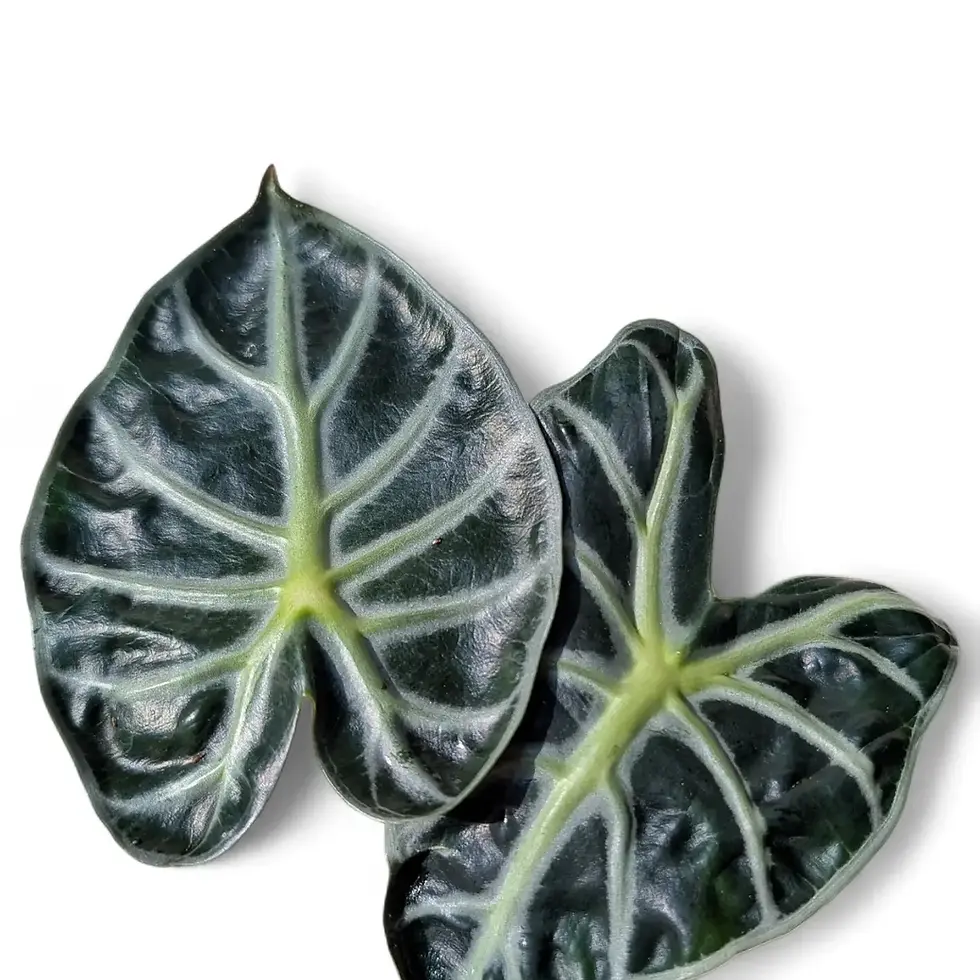
12. Alocasia FAQ — Quick Answers to Common Questions
Q: Does Alocasia go dormant in winter?
A: Sometimes — but not always. Alocasia is a facultative rester. If light, warmth, or humidity drop, it may slow down or pause. But with grow lights and stable temperatures, many species continue growing year-round.
Q: Can I propagate Alocasia from a leaf?
A: No. Alocasia doesn’t propagate from leaf cuttings. You need a rhizome segment, offset, or viable cormel to grow a new plant.
Q: Why is my Alocasia dropping leaves after repotting?
A: That’s normal stress. Repotting disrupts roots and environmental balance. If only one or two older leaves drop and the rhizome is firm, it’s just adjusting.
Q: What’s the best pot size for my Alocasia?
A: Base it on root structure, not leaf span.
Creeping rhizomes need wide, shallow pots
Compact tubers do best in shallow, stable containers
Upright giants need medium-deep pots with drainage
Q: How often should I water my Alocasia?A: Only when the top 2–3 cm of the substrate feels dry. There’s no fixed rule — adjust based on plant signals, not schedules.
Q: Is Alocasia toxic to pets or children?
A: Yes. All parts of the plant contain calcium oxalate crystals. Ingestion can cause burning, swelling, and vomiting in pets or kids. Always handle with care and keep out of reach.
Q: Can I keep Alocasia in LECA or semi-hydroponics?
A: Yes, but it depends on technique. Use an airy mineral substrate, not pure LECA, and maintain good airflow and nutrient balance. Overly wet setups or cold rooms often trigger root decline.
Q: My Alocasia keeps losing leaves — is it dying?
A: Not necessarily. Alocasia often sacrifices older leaves during stress or adaptation. If the rhizome is firm and the roots are healthy, it’s likely adjusting or pausing.
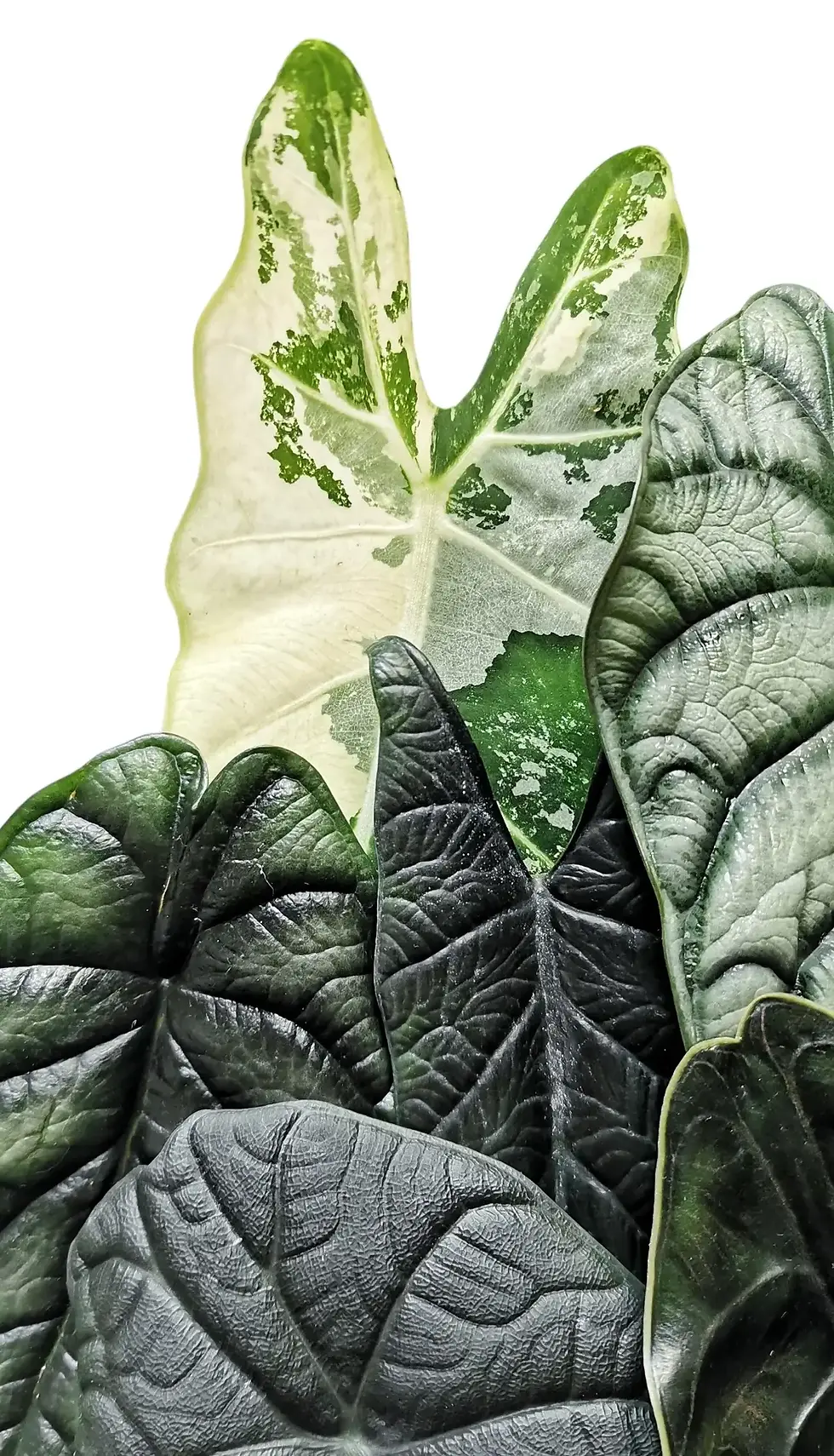
13. Final Thoughts: Mastering Alocasia Is About Alignment — Not Control
Alocasia isn’t “fussy.” It’s just specific.
Once you stop forcing routines and start aligning your care with what the plant actually needs — from below the surface up — everything clicks into place. You’ll stop reacting to symptoms and start reading signals.
With their bold silhouettes, velvety textures, and striking leaf forms, Alocasias offer something rare:→ A plant that evolves with you.
But success doesn’t come from a schedule. It comes from understanding:
Whether you’re growing a creeping rhizome or a compact tuber
Which environment your species actually evolved in
Why airflow, pot depth, and moisture balance matter
When a pause is dormancy — and when it’s a warning
Curious how your Alocasia fits into the bigger picture?
From creeping rhizomes to highland jewel types, our Alocasia genus guide dives into natural habitats, adaptations, and more.
Ready to Grow Alocasia the Right Way?
Whether you're eyeing a towering macrorrhizos, a jewel-like cuprea, or a rare hybrid like azlanii — there's an Alocasia that fits your space, skill level, and style.
🛒 Browse the full Alocasia collection at Foliage Factory — every listing includes:
Species-specific care notes
Substrate and potting recommendations
Light and humidity needs
Propagation and dormancy info based on real-world indoor growing
Thank you for reading — and welcome to Alocasia care that actually makes sense!
14. Glossary – Alocasia Care Terms Explained
Need a refresher on root types, humidity burn, or nutrient lockout? This glossary breaks down every essential Alocasia care term.
Term | |
Aerial Roots | Roots that grow above the soil; in Alocasia, these serve mainly as stabilizers, not for water absorption. |
Anatomy-Driven Care | A care strategy guided by a plant’s structure, root type, and growth habit — not fixed watering or feeding schedules. |
Anaerobic Zone | A waterlogged substrate layer with little to no oxygen; often leads to root rot and harmful microbial activity. |
Cation Exchange (CEC) | The substrate's ability to hold and release positively charged nutrients (like calcium or potassium); important for nutrient availability. |
Chlorosis | General yellowing of leaves due to nutrient deficiency, poor root health, or impaired uptake. |
Corm | A compact, vertical underground storage stem found in some Alocasia species; supports energy storage and dormancy survival. |
Cormel | A small tuber-like offset produced around a corm or rhizome; can grow into a new plant but may not retain cultivar traits. |
Dormancy | A rest phase triggered by cooler temperatures or low light; not all Alocasias enter dormancy indoors. |
Edema | Swelling or blistering of leaves caused by water imbalance — usually from overwatering combined with low light. |
Feeder Roots | Fine, surface-level roots responsible for rapid uptake of water and nutrients; prone to damage from compacted soil. |
Humidity Burn | Tissue damage from excess surface moisture combined with stagnant air; may appear as soft brown patches or fungal spots. |
Hydrophobic Bark | Bark that repels water when dry, causing water to run off instead of absorbing — leads to dry zones around roots. |
Interveinal Chlorosis | Yellowing between the leaf veins, often caused by deficiencies in iron or magnesium. |
Leaf Reversion | Loss of variegation or special leaf traits in hybrids or cultivars, reverting to a more basic green form. |
Mineral Substrate | Inert, non-organic substrate materials like pumice, zeolite, or akadama that improve drainage and resist breakdown. |
Nutrient Lockout | When roots can't absorb available nutrients due to incorrect pH, salt accumulation, or compacted soil. |
pH Imbalance | Substrate acidity or alkalinity outside the optimal range (usually pH 5.5–6.5), which impairs nutrient uptake. |
Petioles | The stalks that attach Alocasia leaves to the main stem or rhizome; length and thickness vary by species. |
Propagation Box | A sealed container or setup that maintains high humidity for rooting corms, offsets, or divisions. |
Repotting Shock | Plant stress from disturbance during repotting — especially if roots are damaged or the new substrate is unsuitable. |
Rhizome | A horizontal underground stem from which Alocasia roots and shoots emerge; common in many species. |
Root Rot | A condition where roots become mushy, discolored, and die off due to overwatering and fungal/bacterial infection. |
Salt Buildup | Accumulation of mineral salts from tap water or fertilizer in the substrate; causes leaf tip burn and root damage. |
Semi-Hydroponics | A growing method using inert media (e.g. LECA) with a passive water reservoir; demands careful balance of moisture and airflow. |
Substrate | The growing medium that supports roots — should balance moisture retention, drainage, and aeration. |
Transpiration | Water loss through leaf pores (stomata), influenced by temperature, humidity, and airflow. |
VPD (Vapor Pressure Deficit) | The difference between humidity inside a leaf and the surrounding air; high VPD increases dehydration risk. |
Velamen | A spongy outer root layer found in epiphytes like Monstera; Alocasia roots do not have velamen, making them more vulnerable to drying. |
15. More information, Sources and Further Reading
Journal Articles and Academic Publications:
Burnett, David (1984).
“The Cultivated Alocasia.” Aroideana 7(3): 68–162. International Aroid Society.
In-depth exploration of Alocasia cultivation, species differentiation, and horticultural practices.
Link: Aroideana – International Aroid Society (subscription needed)
Prameswara, P., & Hay, A. (1999).
“Alocasia tandurusa Prameswara & A.Hay, A new (bi)pinnatifid-leaved species from Sulawesi [Araceae, tribe Alocasieae (Schott) A.Hay], with notes on tribal classification for the paraphyletic grade of 'Old World Colocasioids'.” Gardens’ Bulletin Singapore, 51.
Introduces a new Alocasia species and discusses tribal classification within Araceae.
Link: ResearchGate Publication
Boyce, P. C., & Croat, T. B. (2011 onwards).
“The Überlist of Araceae: Totals for Published and Estimated Number of Species in Aroid Genera.”
Running list of published and estimated species in the Araceae family.
Links:
Krisantini, K., Sri Rahayu, M., Kartika, J. G., & Dinarti, D. (2024).
“Comparative Analysis of Vegetative Development and Leaf Morpho-Anatomy in Three Taxa of Ornamental Alocasia (Araceae).” Horticulturae, 10(8), 778.
Examines vegetative development and leaf morphology in three ornamental Alocasia taxa.
DOI: 10.3390/horticulturae10080778
Link: Horticulturae Article
Arbain, D., Sinaga, L. M. R., Taher, M., & Susanti, D. (2022).
“Traditional Uses, Phytochemistry and Biological Activities of Alocasia Species: A Systematic Review.” Frontiers in Pharmacology, 13, 849704.
Reviews the traditional uses, phytochemistry, and biological activities of Alocasia species.
DOI: 10.3389/fphar.2022.849704
Link: Frontiers in Pharmacology ArticleLicense: CC BY 4.0
Hay, A. (1999).
“The genus Alocasia (Araceae—Colocasieae) in the Philippines.” Gardens’ Bulletin Singapore, 51(1), 1–41.
Provides an overview of the Alocasia genus in the Philippines, including species descriptions and distribution.
Link: ResearchGate, PDF Available
Nguyen Thi Phuong Thao, & Miyajima, I. (2003).
“Micropropagation of Ornamental Alocasia.” Journal of the Faculty of Agriculture Kyushu University, 47(2), 277–282.
Discusses methods for micropropagation of ornamental Alocasia species.
DOI: 10.5109/4496
Link: Journal Article
Boyce, P. C. (n.d.).
“A review of Alocasia (Araceae: Colocasieae) for Thailand including a novel species and new species records from South-West Thailand.” THAI FOR. BULL. (BOT.) 36: 1–17. 2008
Taxonomic overview, new species descriptions, and distribution records of Alocasia in Thailand.
Journal of the International Aroid Society
Articles on Alocasia hybridization, growth studies, and community-based research on the Araceae family.
Books and Manuals:
Armitage, Allan M. (2001).
Armitage’s Manual of Annuals, Biennials, and Half-Hardy Perennials. Timber Press.
Comprehensive reference on growing and caring for annuals, biennials, and tender perennials.
Bown, Deni (2000).
Aroids: Plants of the Arum Family. Timber Press.
An authoritative look at aroids, covering species profiles, biology, and cultivation insights. Online version available here: https://archive.org/details/aroidsplantsofar0000bown
Online Databases and Websites:
Royal Horticultural Society (RHS)
RHS Plant Finder
Authoritative horticultural resources and detailed plant care advice.
Aroidpedia
A comprehensive online resource focusing on aroids, including Alocasia.
Link: https://www.aroidpedia.com
Aroidpedia – AroidGPT
An AI-powered tool designed to generate information and answer questions related to aroids, currently trained for Alocasia.
Link: https://www.aroidpedia.com/aroidgpt
Global Biodiversity Information Facility (GBIF)
Provides broad biodiversity data, useful for distribution records of Alocasia.Link: https://www.gbif.org
Kew Science – Plants of the World Online
Taxonomic information, global distribution data, and identification keys for Alocasia.
Link: https://powo.science.kew.org
Missouri Botanical Garden – Plant Finder
Comprehensive database for houseplant cultivation and pest management tips.
Link: http://www.missouribotanicalgarden.org/PlantFinder/
PhytoImages
PhytoImages - Alocasia Genus
Image-based plant database with taxonomic details for Alocasia.
Link: PhytoImages - Alocasia Genus
Philippine Alocasia Resource Center
Specialized resource center focusing on Alocasia species in the Philippines.
Link: https://sites.google.com/view/philippinealocasias/home?authuser=0
Tropicos
Botanical database hosted by Missouri Botanical Garden, containing taxonomic data for Alocasia.




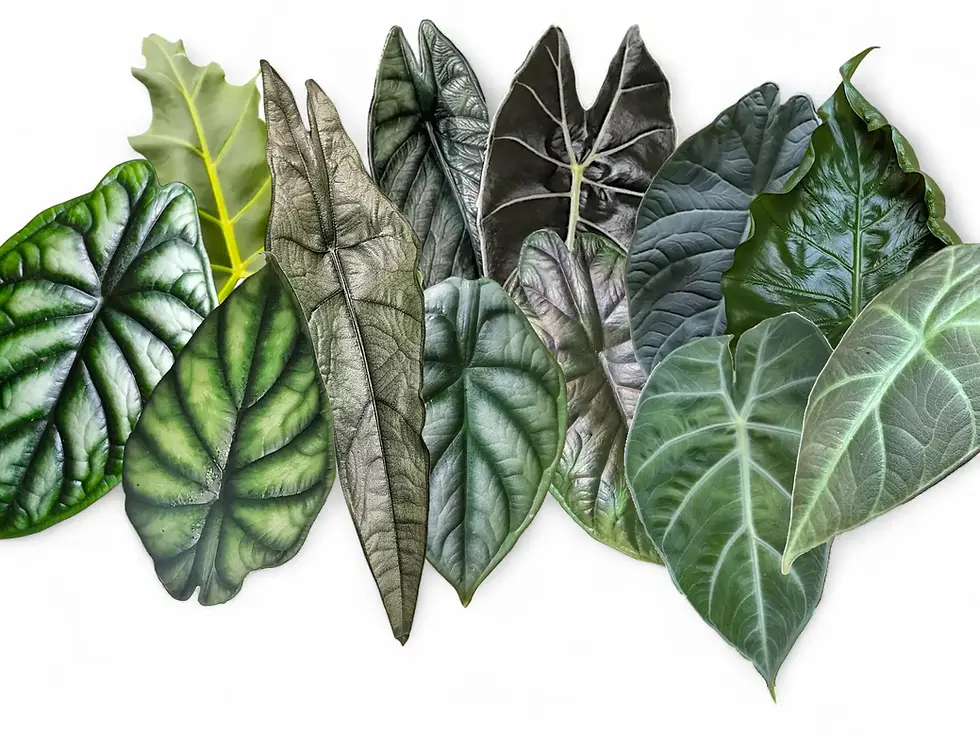


Comments